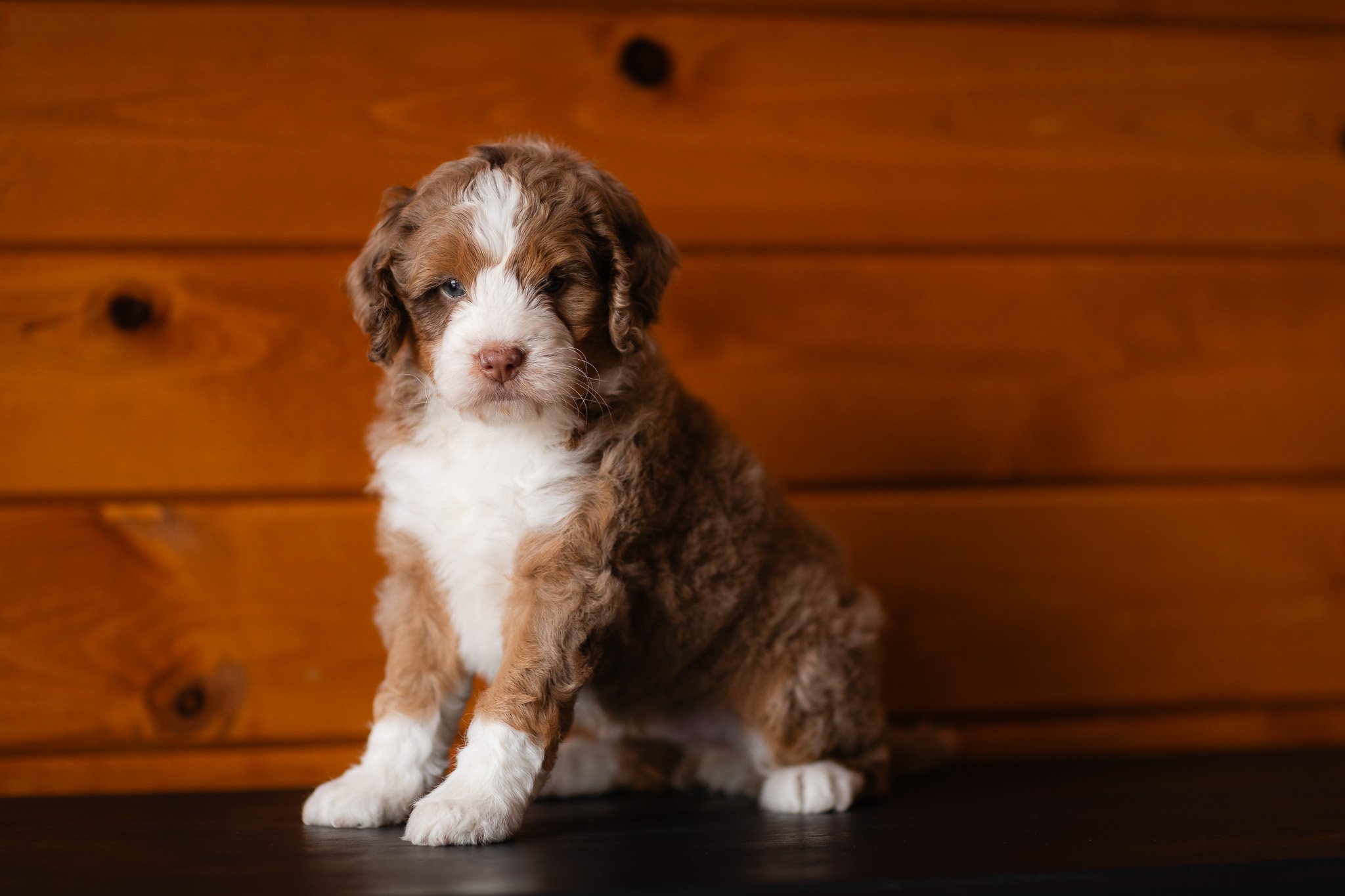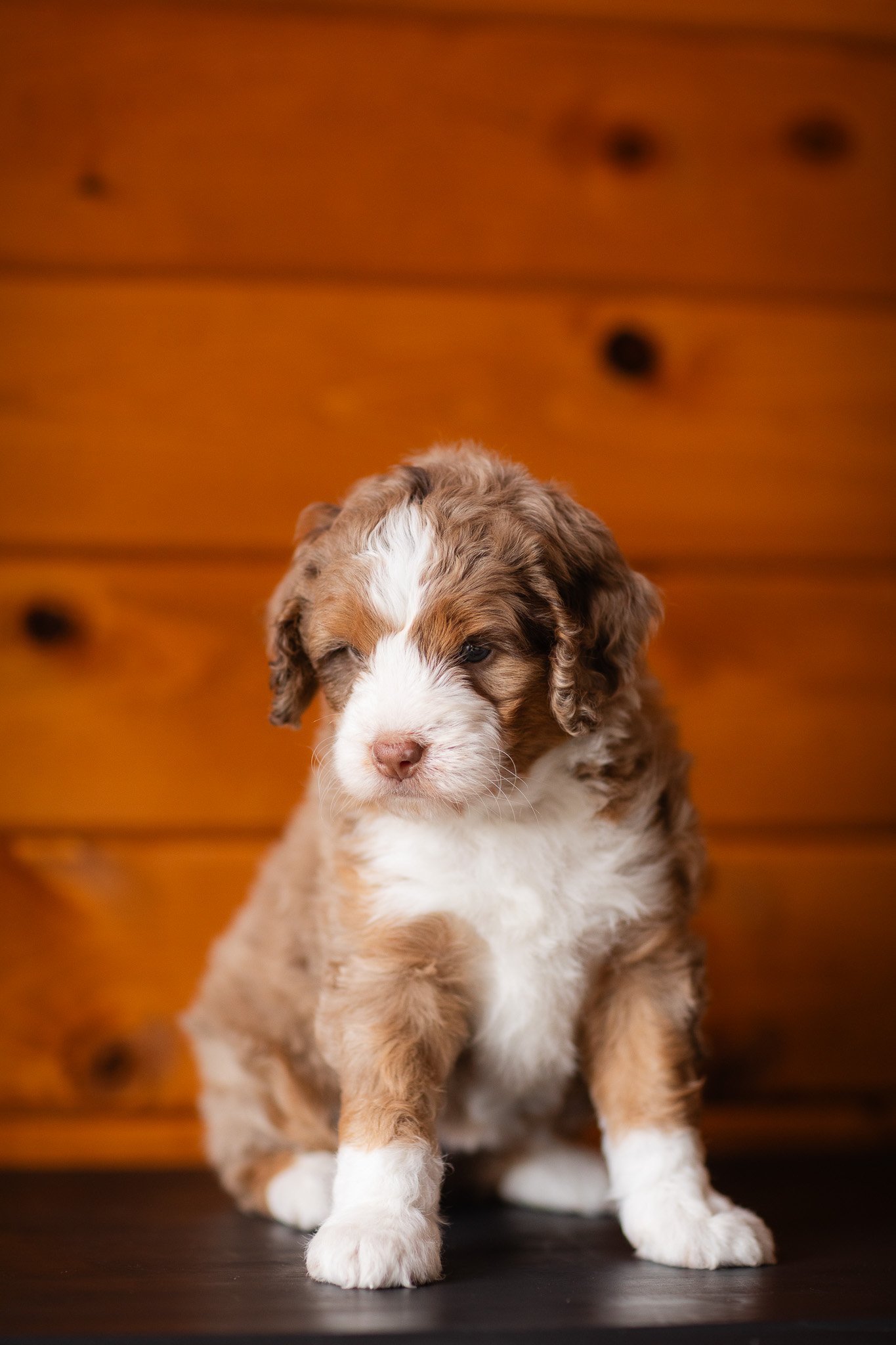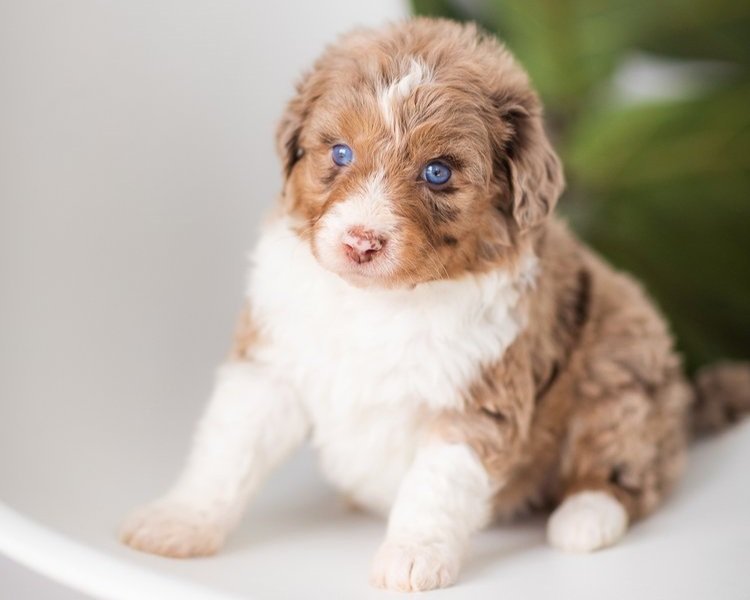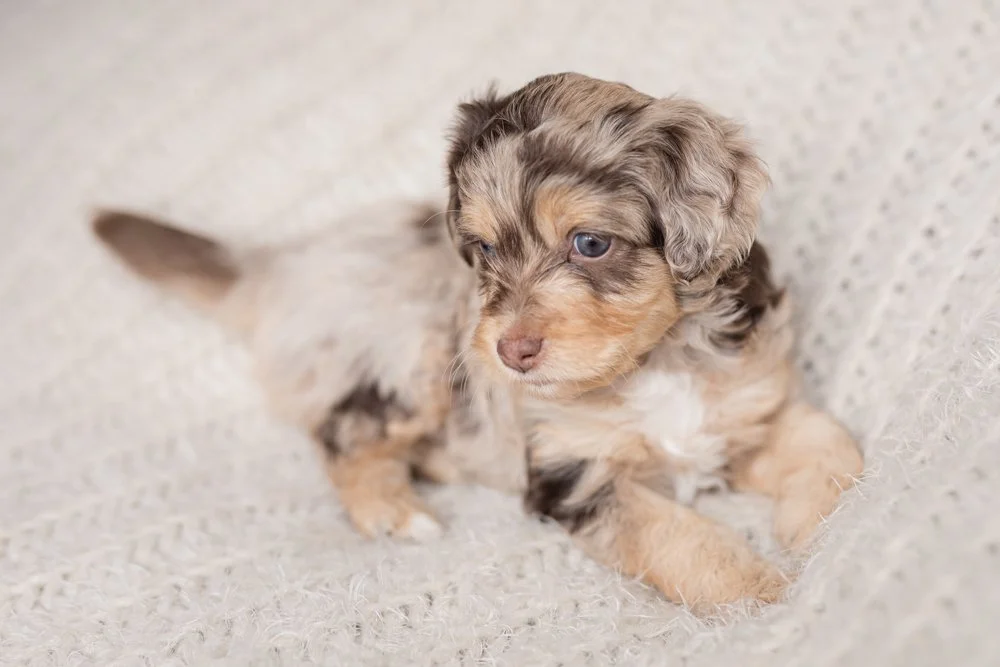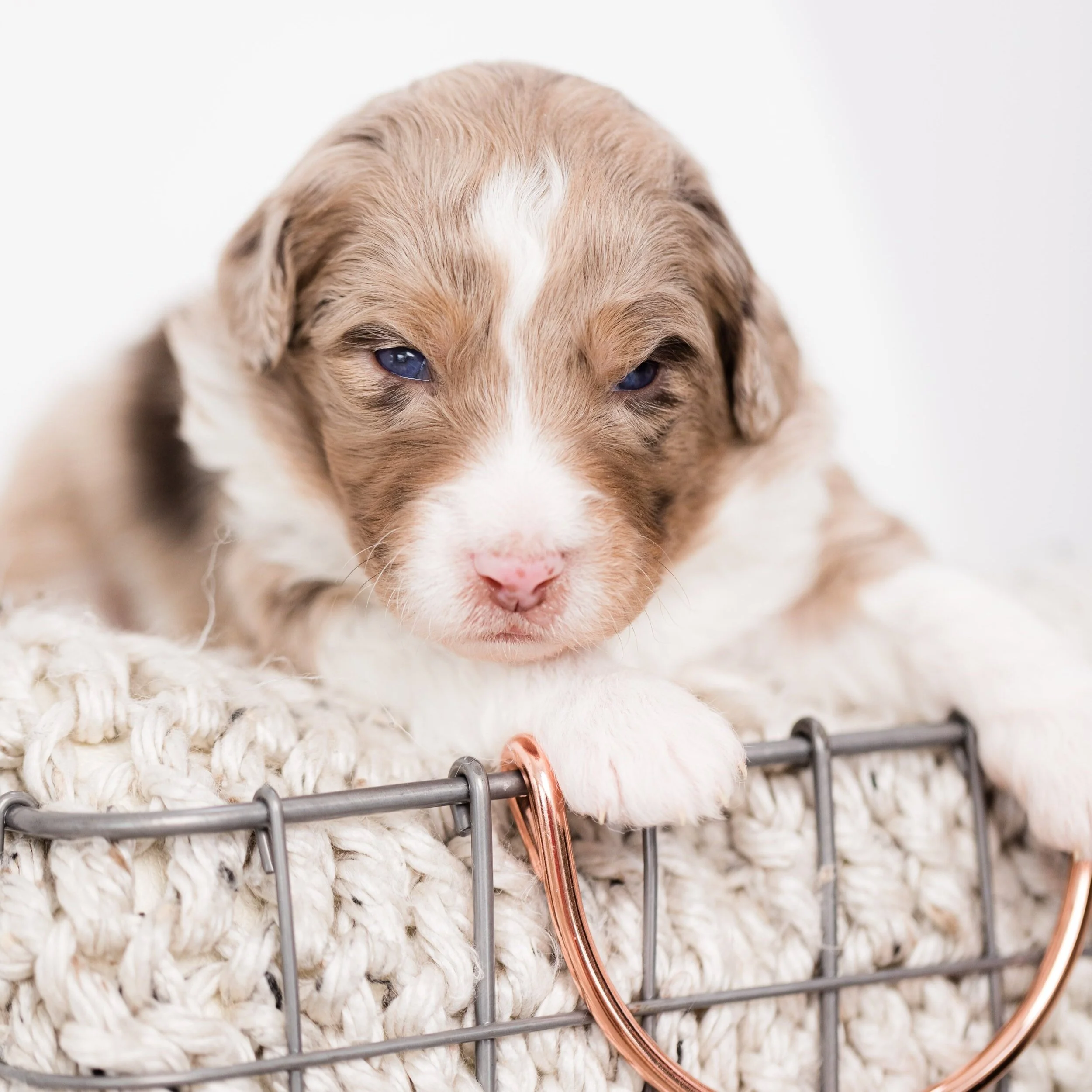What is red merle Doodle?
A red merle doodle is a designer breed of dog that is a cross between a Poodle and an Australian Shepherd, with a red merle coat pattern. The red merle coat is characterized by a mottled mixture of red, gray, and white coloring. These dogs are known for their intelligence, trainability, and friendly, loyal temperaments. Contrary to popular belief, these dogs are no actually red, but brown, however, the merle gene makes the brown coat appear to be reddish in color.
The inheritance of coat color in dogs is a complex trait that is influenced by multiple genes, and it is not as simple as dominant or recessive. Some coat colors are indeed dominant over others, but the expression of coat color is influenced by the interactions of many genes and can also be influenced by environmental factors. The red coat color in dogs is thought to be caused by expression of the "e" locus, which is one of several genes known to be involved in determining coat color in dogs. The exact inheritance patterns for red coat color in dogs are not well understood, but it is known to be influenced by multiple genes and not simply determined by one dominant or recessive gene.
Brown merle or Red Merle is a coat color pattern that can be found in some breeds of dogs, such as the Australian Shepherds, Aussiedoodles, Australian Mountain Doodles, Poodles, & Bernedoodles. In a brown merle pattern, the coat is mottled with patches of brown, red, and gray or silver. The exact expression of the brown merle pattern can vary greatly within a breed and even within individual dogs and is determined by multiple genes. Some brown merle dogs will have more predominant brown patches, while others may have more gray or silver. Like other coat color patterns, the brown merle pattern is a cosmetic trait and has no effect on a dog's health or temperament.
The merle gene can impact eye color in dogs. In dogs with a merle coat pattern, the gene causes patches of the coat to have a lighter color, often appearing as a blue or yellow-ish color. This same gene can also cause changes in the pigmentation of a dog's iris, leading to differently colored eyes, a condition known as heterochromia. This can result in a dog having one blue eye, one brown eye, or eyes with a mix of both blue and brown. It is important to note that not all dogs with the merle gene will have different colored eyes, and the exact expression of heterochromia can vary between individual dogs.
F1 Mini Red Merle Tri Aussiedoodle
It's important to note that designer dogs, like red merle doodles, can vary significantly in appearance and temperament, as they may inherit a mix of characteristics from their parent breeds. It's always a good idea to research both parent breeds when considering any designer dog to get a sense of what traits the puppy may inherit.
Merle coat coloration is characterized by a mottled or patchy appearance, with lighter and darker areas of coloring within the same coat. This coat color is caused by a genetic mutation that affects the production of pigment in the hair. Merle doodles can have a wide range of coat colors and patterns depending on the genetics of the parent dogs.
Like other doodle breeds, merle doodles are often sought after for their intelligence, low-shedding coats, and friendly dispositions. However, it is important to be aware that any crossbred dog can inherit traits from either parent breed, and it is important to carefully research the breed and individual dog before committing to owning one.
Merle arises from a mutation in the pigment gene PMEL (this mutation “M*” going forward). M* disrupts PMEL expression, leading to a mottled or patchy coat color. Dogs with the “M*m” genotype are likely to appear merle or phantom merle, that is, the dog is not obviously merle patterned but has a merle allele; dogs with the “M*M*” genotype are likely to appear merle or double merle. Dogs with the “mm” genotype are unlikely to appear merle. At STOKESHIRE we avoid double merle crosses.
Are brown Merles rare?
Brown (also referred to as "chocolate") is a recessive coat color in dogs, meaning that in order for a dog to express the brown coat color, it must inherit two copies of the gene responsible for brown coat color, one from each parent. If a dog inherits only one copy of the brown gene, it will not express the brown coat color and instead will express the dominant coat color gene that it has inherited. The expression of coat color in dogs is a complex trait that is influenced by multiple genes, so the inheritance of coat color can be difficult to predict and is not always straightforward. In some breeds, other genes may modify or interact with the gene responsible for brown coat color, further complicating the inheritance of this trait.
Punnett squares are a tool used to visually represent the potential offspring resulting from a genetic cross between two individuals. To create a Punnett square for brown coat color in dogs, you would first need to determine the genotype of the parents for the gene responsible for brown coat color.
For simplicity, let's assume the gene responsible for brown coat color has two alleles: B for brown and b for a different (non-brown) coat color. A dog with the genotype BB would express the brown coat color, while a dog with the genotype bb would not express the brown coat color. A dog with the genotype Bb would also not express the brown coat color, as the dominant allele (b) masks the expression of the recessive allele (B).
Here is a Punnett square for a cross between two dogs, both Bb (heterozygous non-brown):
| B | b--|---|--B | BB| Bbb | Bb| bb25% of these two dogs will produce puppies with brown coats. To create a Punnett square for a cross between a dog with the merle gene and a non-merle dog, you would first need to determine the genotype of the parents for the merle gene.
For simplicity, let's assume the merle gene has two alleles: M for merle and m for non-merle. A dog with the genotype MM would express the merle coat pattern, while a dog with the genotype mm would not express the merle coat pattern. A dog with the genotype Mm would also express the merle coat pattern, as the dominant allele (M) masks the expression of the recessive allele (m).
Here is a Punnett square for a cross between a dog with the genotype Mm (heterozygous merle) and a dog with the genotype mm (homozygous non-merle):
| M | m
--|---|--
M | MM| Mm
m | Mm| mm
In this Punnett square, we can see that half of the potential offspring would have the genotype Mm, which would express the merle coat pattern, and half of the offspring would have the genotype mm, which would not express the merle coat pattern. This Punnett square is just a theoretical representation of the possible offspring, and in reality, the actual offspring may have different genotypes or phenotypes due to the complexity of the inheritance of the merle gene and other genes that may interact with it.
Merle Mutation information
This has to do with the nature of the M* mutation itself. M* is actually a specific type of transposable element (a “jumping gene,” a vestige of a retrotransposable viral element) known as a SINE. This SINE has jumped right into a gene involved in coat pigmentation called PMEL, thereby disrupting its function (as described in Clark et al, 2006).
What is uncommon about M* is that it can, and does, mutate rapidly a single generation, or even across a cell division. This means that a phenotypic merle dog can produce puppies with different lengthed merle alleles. A merle dog could also have several merle alleles–these dogs would be called mosaics. And, the length of the merle allele determines the coat pattern of the dog.
If you have been breeding Aussiedoodles for any length of time, it is likely that at some point your dam has whelped a pup which has left you mystified by what you were seeing. Perhaps white body splashes that were not expected and are not to standard; dilute looking pups when d/d is not a possibility; brownish or off-shading on a black offspring; excessive white offspring and yet one parent is phenotypically solid; Merle offspring that were expected as neither of the parents express a Merle pattern; a solid pup when one parent is M/M and all pups should be Merle; an unusual Tweed Merle pattern unlike that of the Merle parent and other litter mates. The Tweed phenotype is described as a Merle pattern that expresses random shaded-in or solid areas, usually with two or three distinguishable shades. Once thought to be a modifier of Merle and now shown to be created by several different Merle genotypes.
Mosaicism - “Somatic Mosaicism” or “Somatic Mutation” is the presence of two or more types of cells with different genotypes present in the body of one individual dog. Merle mosaicism results from the shortening of the poly-A tail in one cell in the early stages of embryo development. This mutation is then replicated during cell division. The shortened length/allele will be present in only some of the adult cells and in different parts of the body. From 308 Merle dogs tested, 56 are mosaics - an average of 18% or 1 out of every 5.5 dogs having 3 or more different alleles on the M locus, indicating that mosaic results are not uncommon.
Any dog tested as m/Mc or Mc/Mc can safely be bred to M with the Mc allele acting the same as non-Merle. A dog who is Mc/M will have no pigment deleted to white due to the allele combination.
Red Merle Tri Mini Aussiedoodle Puppy with Blue Green Eyes
"Many solid dogs are actually cryptic or phantom merles and can produce both Merle and double merles. A cryptic ghost or phantom Merle is a dog which phenotypically appears to be a non-merle or very faint patches of Merle that can go unnoticed. Animals that do not present the Merle phenotype may possess the Merle genotype and subsequently produce Merle offspring. These dogs are known as cryptic Merles."
In 2006, Dr. Leigh Anne Clark and others identified a semi-dominant genetic mutation responsible for the merle coat color pattern commonly seen in numerous dog breeds including the Australian shepherd, collie, border collie, and dachshund. Merle's coat color is marked by areas of normal, melanistic pigmentation separated by areas of diluted pigmentation. Unlike the many known simple, mendelian phenotypic traits of dogs, merle dogs are the result of a SINE element in the canine PMEL gene containing a polyadenine (poly[A]) tail of variable length resulting in phenotypic heterogeneity as reported by two independent groups in 2018 (Murphy et al. and Ballif et al.).
A continuum of poly(A) tail lengths from dog to dog results in a spectrum of colors and patterns which have been grouped into at least 4 phenotypic merle groups controlled by the relative length of the individual’s poly(A) tail. From shortest to longest, the phenotypic groups proposed by Ballif and others were “cryptic”, “atypical”, “classic”, and “harlequin”.
Cryptic merle dogs show no coat color changes or only very small merle patches.
Atypical merle dogs can have several different changes to their coat including reddish undertones, diluted coat color, or other anomalies.
Classic merle dogs have large, irregularly shaped fully pigmented regions separated by areas of diluted coat color. In some cases, classic merle dogs may only display coat color dilution in limited areas of the body.
Dogs with the longest poly(A) tail display a pattern referred to as harlequin in which hair between dilute and fully pigmented regions is completely white. In some cases, dogs in this group have a pattern known as “patchwork” or “tweed” in which the coat displays multiple colors of multiple shades, with or without white.
Red Merle Doodle with Blue Eyes
Though these general phenotypic groups associated with poly(A) tail length apply to the majority of merle dogs, multiple examples of exceptions to these groups have been reported, indicating that other factors also contribute to the merle phenotype of an individual.
Somatic vs Germline Mosaicism
Repetitive DNA sequences and poly(A) tracts such as the one on the merle-associated insertion are known to be prone to error during replication due to an inherent inability of the enzyme, DNA polymerase to accurately replicate the template DNA strand. The resulting strand slippage and mispairing of nucleotides can result in either contraction or expansion of the original sequence. While most contractions or expansions tend to change the tail length by only a few bases, in some cases, large contractions or expansions occur.
Errors occurring in somatic cells during cell divisions related to development result in variability in the length of the poly(A) tail from cell to cell of an individual. The genetic changes related to this phenomenon, known as somatic mosaicism, cannot be inherited by the individual’s offspring and are likely responsible for the randomness of the merle pattern. Murphy et al. speculated that variability in poly(A) tail length from cell to cell may underlie the merle phenotype due to the variable impact on pigmentation. Errors occurring in the germ cells of merle dogs during gametogenesis result in ova and sperm with variable poly(A) tail lengths; a phenomenon known as germline mosaicism. Genetic changes occurring in the PMEL gene during gametogenesis in merle dogs are passed on to offspring during reproduction.
Merle Association with Disease
The beauty and unpredictability of the merle coat pattern has shown to be highly desirable to dog lovers and fanciers alike. However, this beauty comes with great breeder responsibility due to the nature of the way merle is inherited and related health concerns. Since merle is a semi-dominant trait, dogs must only inherit one copy of the merle insertion (from a single parent) to display a traditional merle coat. However, dogs homozygous for the merle insertion are at risk of being born with an extreme white phenotype with limited areas of pigmentation which is often diluted. These “double merle” dogs are also at risk for auditory and ophthalmologic aberrations including deafness, microopthalmia, and colobomas as well as variety of other abnormalities. Interestingly, homozygous merle dogs which inherit insertions with poly(A) tail lengths in the small, “cryptic” range are less likely to display disease phenotypes despite technically being “double merle”. Some blood lines regularly produce homozygous mutants with one copy of the cryptic merle insertion and one copy of the classic merle insertion without producing diseased dogs. However, the rare and unpredictable chance of large expansions in the poly(A) tail in gametes of cryptic merle dogs make recommendations to routinely breed cryptic merle to classic merle dogs difficult to make. Offspring inheriting an expanded allele from the cryptic merle parent (expanding back to a classic merle size) and a classic merle allele from the merle parent will be at very high risk of the extreme white and disease phenotypes. It is for this reason that Paw Print Genetics recommends that all dogs which are expected to be bred to a merle dog, undergo genetic testing at the M (merle) Locus for the merle insertion. If the non-merle dog is found to have the insertion (regardless of length), the safest and most predictable approach to avoid producing merle-related disease would be to find a different, non-merle mate which has not inherited the mutation.
Red Merle Tri Poodle Puppy with Blue Eyes
Though it is commonly recognized that dogs homozygous for the merle insertion are at high risk of pathology, in at least one study, heterozygous merle dogs were also reported to be at a significantly increased risk of unilateral or bilateral deafness compared to dogs without the mutation. Another study also found a significant correlation between deafness and the merle phenotype without consideration to genotype. In addition, merle puppies with two blue eyes (a common finding in merle dogs) and merle puppies with an excessive amount of white on the head were also significantly more likely to display deafness. However, since genotypes were not obtained in this study, it is possible that some of the deaf dogs in this study were actually homozygous for the merle-associated insertion (of variable lengths), thus placing them at an increased risk for hearing problems despite not displaying the extreme white “double merle” appearance.



